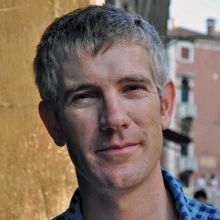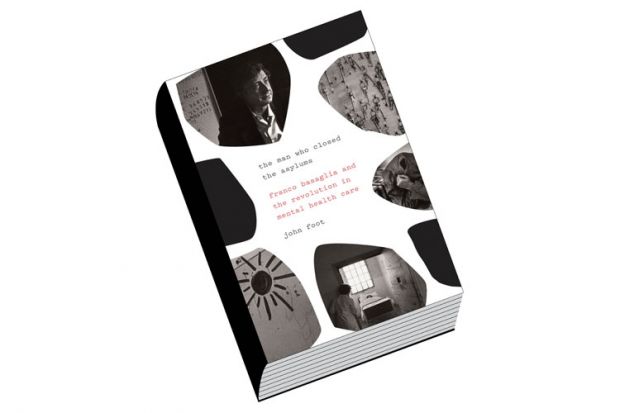In March 1973, a large blue papier mâché statue of a horse was towed through the streets of Trieste. It began its journey in the San Giovanni asylum, accompanied by flag-waving patients. It had been fashioned by an eclectic group of artists, students, staff, sociologists and volunteers in what was no longer a “closed” institution, and some of the patients’ “dreams and hopes” written on scraps of paper went into its composition.
Marco Cavallo, as it was known, had been named by a patient in honour of the horse that had carried the asylum’s laundry, able to come and go as the incarcerated could not. In a moment of high drama, its exit involved breaking down the doors of the former ward where it had been built. The modern-day afterlife of Marco Cavallo (or at least a durable copy of the original) includes a Facebook page and a Twitter account at @marcocavalloblu. The statue is used by mental health advocates and continues its peregrinations within and beyond Italy. Currently on show at Expo Milano 2015, it is a symbol of what is desirable and possible for those living with mental illness, and a testimony to the internationally recognised Trieste model of non-institutional, socially inclusive psychiatric care.
John Foot probably won’t thank me for beginning with the blue horse. It speaks of mythology and the oversimplification of a story that he is at pains to disassemble, enrich and even muddy: the work of psychiatrist Franco Basaglia and the changes he galvanised in Italy’s custodial care of the mentally ill from the 1960s through to the passing of the “Basaglia law” in 1978, which officially shut the asylums. Marco Cavallo’s creation is, however, a striking moment, arguably even an inspirational one. Foot describes a similar moment in 2008 when he watched a 1970s documentary about a Venetian asylum, and was moved to write about what happened in Italy during the anti-psychiatry movement.
Foot has subsequently had access to the Basaglia archive and has made wonderful use of it, exploring the fascinating careers of Basaglia, his wife, Franca Ongaro Basaglia, and various colleagues in greater depth and nuance than they have previously enjoyed. Although Basaglia is justly famed in Italy, the complexities of his work are less well known elsewhere.
A scholar steeped in the twists and turns of Italian history in the 20th century, Foot has written histories of football and cycling that do not simply celebrate the beautiful game as played in Italy, or the second most famous cycle race in the world, the Giro d’Italia, but undertake to explore them through the lens of the politics and fractured nature of the country itself. The same approach can be seen here. Foot’s interest is in Italy’s collective memory – questions about what is remembered and what is forgotten pervade this book. What do Italians want to recall about the institutions that were the sites, from 1904 to 1978, for forced carceral “treatment”? How do they want to tell the story of these institutions’ overthrow as part of political and social upheavals in 1968 and beyond?
It is here that Marco Cavallo’s story seems particularly apposite, as the blue horse’s symbolic liberation was accompanied by a now-forgotten leaflet signed by the staff and artists in the Trieste asylum. It was a radical manifesto, presenting a series of social and political demands: “working hours, housing for patients, resources to support the closure of the hospital”. Foot explains that Marco Cavallo’s creation wasn’t merely an expression of Basaglia’s philosophy and penchant for using media attention to productive ends, but had “explicit links to strikes and other struggles”. While the horse lives on, what Foot terms the “radical, social edge” of the leaflet is unremembered. Few people today in the field of mental health, with its emphasis on biology, aim to hold capitalism and its social structures to account as Basaglia and his fellow radicals attempted to do.
The San Giovanni asylum in Trieste would be the last of the asylums that Basaglia directed. The first, when he left the academic world in 1961, was in Gorizia, in the extreme northeast of the country. After 1947, the Italian-Slovenian border passed close to the walls of the asylum, reminding those incarcerated and working there of the region’s turbulent 20th-century history and the social and political problems of the mixed Slavic and Italian population. The extent to which the asylum was used to house those who were outsiders because of their views or their ethnicity, or those whose peace of mind had been destroyed by their suffering, is still debated.
Basaglia’s horror at what he found in the Gorizia asylum spurred him to effect change. Perhaps desirous of avoiding voyeurism, Foot conveys only limited details; it is enough to briefly list that patients were found caged or routinely tied to their beds, that some were found writhing in their own excrement, that there was no engagement, stimulation or purposeful activity, no autonomy or acknowledgement of a patient’s identity, and no hope that any of this would ever alter. The inspiration for a poster by Piero Gilardi bearing the slogan Manicomio = Lager (Asylum = concentration camp) is clear.
This bare-bones list of atrocious conditions is repeated when any of the book’s main protagonists in the decarceration movement has their own anti-institutional epiphany. Foot’s approach is to offer, in short chapters and sections, a series of accounts told from different vantage points. The result is punchy and staccato, at times rather losing its edge because of the inevitable repetition, but effective nevertheless. He is keen to ensure that other figures receive the attention that Basaglia’s reputation has overshadowed. Not all are psychiatrists. Mario Tommasini and Ilvano Rasimelli were regional government politicians who could not countenance presiding over such horror and took independent action. Although we hear little of the voices of patients (partly because many records have been lost or destroyed), they are treated with respect. Also hugely influential as conduits, as Foot details, were publishers such as Einaudi and Feltrinelli, who issued titles written by Basaglia and others, and high-profile television documentaries and films, particularly Sergio Zavoli’s I giardini di Abele.
Basaglia died of a brain tumour in 1980 before he could witness the final end of the asylum system. In Gorizia, he and his colleagues and followers had created a “therapeutic community”, but although it was a vast improvement, it became a gilded cage. Only total closure of the asylums would bring about the kinds of change that Basaglia and others considered necessary. But deinstitutionalisation was not without problems, including suicides, murders and families reluctant to be burdened with relatives who had spent years locked away.
Foot’s admiration of Basaglia is understandable, but he avoids oversimplification and reducing the history of Italian decarceration to that of one man. Basaglia was aware of the dangers of hero worship, too. He feared that he had become a kind of institution to which people would turn, seeking easy answers to life’s difficult questions, and he acknowledged his error in denying the reality of mental illness. Law 180 (the “Basaglia Law”) was passed in May 1978 and amended during its incorporation later that year amid a more widespread overhaul of health legislation, known as Law 883. It was the beginning of another, overlapping story in the care of the mentally ill in Italy. Foot hints that he will write it, and I hope he does.
Helen Bynum is honorary research associate in the department of anthropology, University College London.
The Man Who Closed the Asylums: Franco Basaglia and the Revolution in Mental Health Care
By John Foot
Verso, 424pp, £20.00
ISBN 9781781689264 and 9288 (e-book)
Published 18 August 2015
The author
 John Foot is professor of modern Italian history at the University of Bristol, and an Inter Milan fan. “When I arrived in Milan in 1988 they won the championship. It seemed like a sign. It wasn’t. They didn’t win again for 20 years. My Italian ex-wife and her mother were both Inter fans. And then there was the Berlusconi factor...”
John Foot is professor of modern Italian history at the University of Bristol, and an Inter Milan fan. “When I arrived in Milan in 1988 they won the championship. It seemed like a sign. It wasn’t. They didn’t win again for 20 years. My Italian ex-wife and her mother were both Inter fans. And then there was the Berlusconi factor...”
He shares a home in Bristol with his partner Sarah and their daughter Corinna, and has a son who lives in Milan. “Sarah is an extremely creative and inquisitive person who has helped me a lot with my work. She also gives great advice on how to rise above petty academic disputes.”
Foot was born in London, and raised in North London “with frequent trips to Cornwall. My upbringing was unorthodox and bookish. My great-grandfather was a Liberal MP and Methodist preacher with one of the biggest private book collections in the country. He passed on his obsession with books to my great-uncle, Michael Foot, and my father, [journalist and activist] Paul Foot. My mother, Monica Foot, worked as a journalist and press officer for Equity and the Labour Party. It was a highly political household (or households) but with other passions – sport above all. My interest in dissenters and rebels certainly comes from this background, as does my love of words, books and libraries.”
His mother “is a voracious reader and consumer of culture. She would take us to the opera (which we hated at the time, but we now love) and to the theatre. We saw a five-hour production of the Oresteia when we were teenagers. She also took us to the Roundhouse and to numerous black and white films at the Everyman cinema in Hampstead, and the National Film Theatre. My mum also ignited in me a love of Italy – through trips to Venice (her favourite place) and to Rome.”
As a child, Foot recalls, he was “extremely studious – a swot you might say. I was lucky enough to have some extraordinary teachers at the North London comprehensive I attended in the 1970s and 1980s – in English, geography and science. It was a superb education.
He took his first degree at the University of Oxford. As an undergraduate at Oriel College, Foot says he was “shy at first, then increasingly political (it was the time of the miners’ strike). I studied hard but also played football, cricket, basketball and even korfball. There were some great people and some terrible people there (some of whom currently govern us). It was a privileged education. I did a whole course where it was just me and the tutor. My maternal grandparents lived in Oxford – my grandfather Robert Beckinsale was a geography don at the university – so I saw a lot of them.”
His doctoral study was carried out at the University of Cambridge, where his supervisor was Paul Ginsborg, the eminent historian of modern Italy.
“My interest in the country predated working with him – both through the holidays described above and through the fact that my father’s mother was half-Italian (she spoke the language). But Paul was a great inspiration to me as a teacher and a scholar. He ‘sent’ me to Milan, saying ‘nobody has worked on Milan’, and I loved it – it was the end of the 1980s and changes were afoot in the city and in the country. It was exotic and fascinating and I learned the language very quickly. I stayed 20 years, commuting back to London for work.”
Foot, who has written critically acclaimed and best-selling books on professional football and cycling in Italy, Calcio and Pedalare! Pedalare!, says that “Italians are very open to foreign academics studying their culture.”
When researching these books, he observes, “My nationality was probably a bonus – although there are always people who ‘mansplain’ things I already know! I received long lists of ‘errors’ in Calcio (very tiny but important details), which I corrected. Some were scathing. Some think that if you are a fan you cannot also be a historian. Football is useful because it creates a universal language – which is a crucial form of communication.”
Although he has given lectures at the Politecnico di Milano, he has never held a permanent academic post in the country.
“For a time I thought about it – and there are a lot of marvellous people working in Italian universities,” Foot says. “The students are very well prepared and highly motivated; their school education is at a very high level. But there are also serious problems – hierarchies, corruption, huge numbers of students, outdated courses (and the study of sport is not seen as a serious academic discipline by many). It’s all a bit of a mess at the moment and I don’t regret not having seriously tried to work in the system. In any case, it is almost impossible for a foreigner to enter the Italian university system – which is something of a scandal.”
Should we be content that Basaglia and his colleagues managed to bring about the end of asylums in Italy, even though their broader political aims were not recognised? “Absolutely. The asylums were terrible places – although, ironically, Basaglia and his allies made them into much better places by the time they were beginning to be closed down,” Foot insists.
“The closure was a great victory for humanity and for democracy – 100,000 people had been effectively removed from society. But, of course, there were problems with the post-closure treatment of mental illness (something I only touch on in my book, which ends with the 1978 law that called for the closure of Italian asylums). The Italian experience, as I argue in my book, has been completely misunderstood in the UK. My book is, in part, an attempt to redress this misrepresentation.”
What gives him hope? “Jeremy Corbyn. Historians like Ian McCalman whose brilliant book The Reef I am currently reading. The stories I tell in my book of those who started struggles from nothing, such as when Franco Basaglia refused to ratify the tying up of patients in the Gorizia asylum – his first institutional ‘no’ (many would follow). Alexis Sanchez. Films like Virunga or The Look of Silence. Wendy Davis’ 13-hour speech. The breadth and beauty of a book like Congo, by David van Reybrouck. My daughter who asks ‘why?’ 500 times a day, forcing me to think of the answers to all her questions.
“But these are dark days,” he adds.
Karen Shook
POSTSCRIPT:
Print headline: Throw away the locks and keys
Register to continue
Why register?
- Registration is free and only takes a moment
- Once registered, you can read 3 articles a month
- Sign up for our newsletter
Subscribe
Or subscribe for unlimited access to:
- Unlimited access to news, views, insights & reviews
- Digital editions
- Digital access to THE’s university and college rankings analysis
Already registered or a current subscriber? Login




